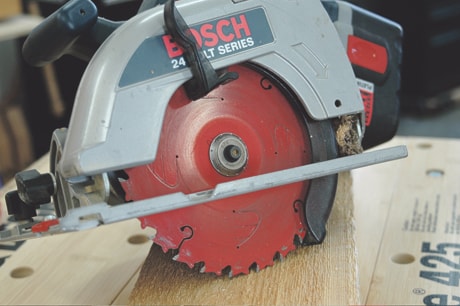Summer’s the best season to make your outdoor building plans a reality, but there’s something you need to realize.
The handheld circular saws and chop saws that are a mainstay of deck, dock and porch construction never come from the factory with blades that let these tools live up to their potential.
Stock blades are something like the tires that come on new cars. They get the job done, but they’re nothing special. Even the world’s best saws are only as good as the blades they spin, and it’s not unusual for a huge gap to exist between the quality of a terrific new saw and the ho-hum blade they put on at the factory.
This is why investing in a blade upgrade makes so much sense.
The world’s best saw blades have never been cheaper than they are these days, and they’re an often overlooked part of achieving the most successful building results.
Today’s thin kerf blades for hand-held circular saws are a good place to start.
There are two reasons why. The most obvious is the way they leverage the greatest slicing power from a given saw motor.
A thin blade chews up less wood than a thick one with each cut, and this is especially important with moderately powered hand-held cordless saws that are 18-volts or less.
Another advantage of a top quality circular saw blade is less obvious but more important: safety. Low friction coatings and anti-kickback tooth designs make premium thin kerf blades more predictable and safer to use.
Working with a sliding compound miter saw offers one of the most effective ways to improve the quality of your outdoor projects.
That’s because they make it easy to cut wood precisely at many different angles.
The $60 to $80 you’ll pay for a premium 10-inch or 12-inch diameter chopsaw blade might seem steep, until you realize how many years it’ll last.
A good carbide blade can be resharpened often enough that it becomes almost a lifetime investment for most backyard do-it-yourselfers.
Few handy homeowners realize how useful a miter saw can be for installing aluminum soffit, fascia and eavestrough.
Yes, a chopsaw is perfect for cutting non-ferrous metal.
All you need is a blade made especially for cutting this material.
You’ll get best results if you lubricate the teeth of the spinning blade with a couple of shots of WD-40 after each few cuts.
Also, take the time to clean aluminum shavings from your saw to prevent scratching the factory applied paint on the soffit, fascia or aluminum siding you’re using.
It pays to apply self-sticking felt pads to the support areas on either side of your saw to keep the painted aluminum pristine.
Safety glasses and hearing protection are important for working safely with any kind of power tool, but it’s especially crucial when cutting metal. Also, keep bystanders safely away from cuts because of the danger posed by flying metal shavings.
Ever thought of building projects from steel? Specific low RPM miter saws are designed to cut steel and other iron-based metals using carbide saw blades instead of the more traditional abrasive wheels.
Steel-cutting blades have teeth just like those for sawing wood, and they work better than abrasives in three ways.
Cuts are unbelievably smooth and burr-free, they generate no heat build-up in the metal, and there are no sparks while cutting.
Enthusiasm alone is never enough to build well. You’ve got to have the right tools, too.
And when it comes to saws, optimal results also depend on a small investment in the right blade for the jobs you’ll tackle this summer.
Steve Maxwell is Canada’s award-winning home improvement expert, and technical editor of Canadian Home Workshop magazine.
